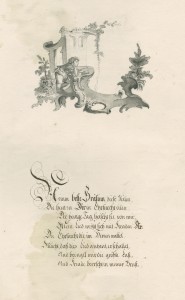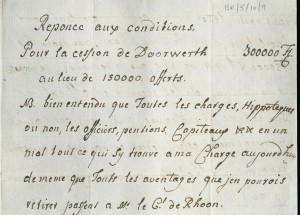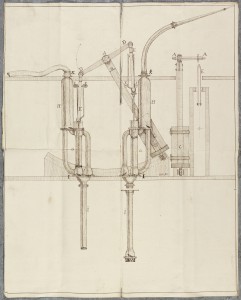January 27, 2015, by Kathryn Summerwill
The Countess, the Castle and the Captain
An interesting collection of documents has recently been catalogued and made fully available to researchers. The Bentinck family, Counts of the Holy Roman Empire, were cousins of the Dukes of Portland (see their family tree) The first Count, William Bentinck (1704-1774), inherited the Dutch lordships of Rhoon and Pendrecht. In 1733 he married Charlotte Sophie, the only daughter and heir of Anton II, Count von Aldenburg, of Varel in modern day Lower Saxony, northern Germany.
Charlotte Sophie (1715-1800) is well known in The Netherlands from her portrayal in the 1996 Dutch language TV mini-series Charlotte Sophie Bentinck. The series concentrated on the scandal of her separation from her husband in 1739, and her affair with her cousin’s husband, Count Albrecht Wolfgang of Schaumburg-Lippe, which resulted in the birth of two illegitimate sons. Charlotte Sophie’s actions were severely punished by her husband. He was awarded the German property that she had brought into the marriage, and she was never again allowed to see her two legitimate sons.
The Countess lived in various European cities during her long life, and was a cultured, fearless and interesting woman. She developed close friendships with Frederick the Great of Prussia, Empress Maria Thérèse, the French writer and philosopher Voltaire, and the German writer Luise Gottsched. The collection (BK) includes only a few personal papers, but amongst them are a number of poems in German, including a soft-bound booklet containing four handwritten verses in German, with pen-and-ink illustrations, produced in Leipzig in 1757 and dedicated at the ‘Hohe Damens Fest’ to Charlotte Sophie von Bentinck, née Grafin von Aldenburg (BK 7/2).
Many of the documents in the collection relate to Charlotte Sophie’s fight to retain her small estate at Doorwerth, near Arnhem in The Netherlands. The medieval Doorwerth Castle had been her father’s property. After Count William’s death in 1774, his daughter-in-law Catherine Maria Bentinck – the widow of William and Charlotte Sophie’s eldest son Christian – took possession of Doorwerth on behalf of her young children, despite the fact that Charlotte Sophie had been employing her own people there.
A legal case over its ownership was heard at The Hague in 1781, and was won by the Countess. However, in the turmoil caused by the French invasion of The Netherlands in the 1790s, Charlotte Sophie agreed after all to bequeath Doorwerth to Christian’s eldest son William G.F. Bentinck, Count Bentinck-Rhoon (1762-1835) – as long as he paid the debts secured on the property. This document, dating from around 1794, was handwritten by Charlotte Sophie and shows her personal involvement in trying to negotiate a deal, even at the age of nearly 80. (BK 5/10/9)
When Charlotte Sophie died in 1800, the situation had changed. She finally bequeathed Doorworth to another of her grandsons, Vice-Admiral William Bentinck (1764-1813) of Terrington St Clement, the son of her second son Captain John Albert Bentinck. The Countess had met William for the first time in 1789, when he travelled to Germany to meet her with his friend James Hawkings-Whitshed. Whitshed later married William’s sister Sophia H. Bentinck, with whom the Countess had an intimate correspondence until her death in 1800 (Pw F 10081-10343), revealing Charlotte Sophie’s increasing attachment to the members of her ‘new’ family and her delight in knowing her grandchildren.
Sadly, Charlotte Sophie was never able to meet Captain John Albert Bentinck, who had died in 1775. Despite his Dutch and German parentage, John Albert Bentinck had inherited the Terrington St Clements estate in Norfolk which had been owned by his grandfather the 1st Earl of Portland, and he settled in England. Destined for a British naval career, he first went to sea at the age of 14. He was promoted to the rank of Captain in 1759, but his time in the Navy is now best remembered for his inventions for use in ships. He gave his name to ‘Bentinck shrouds’, the ‘Bentinck boom’ and also to a triangular mainsail which became known as simply ‘the Bentinck’. Perhaps his most important innovation, though, was the Cole-Bentinck pump, a much more reliable and efficient version of a standard chain pump, which was developed with William Cole between 1767 and 1774 and was adopted for use in all Royal Navy ships. The papers of the Bentinck family contain letters and papers of Captain John Albert Bentinck (BK 6/1), including correspondence in French with his father, 1759-1760, and letters, notes and some sketches relating to his inventions.
All of the documents are available for anyone to consult in our Reading Room at King’s Meadow Campus. For more information about Manuscripts & Special Collections, visit our website or follow us @mssUniNott.
No comments yet, fill out a comment to be the first




Leave a Reply